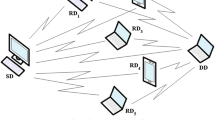Abstract
Device-to-device (D2D) communications allow direct connections among devices to lower transmission latency and network loads of the existing cellular mobile networks. To fully exploit the benefits of D2D communications, relay access is one of the critical challenges upon employing the optimal cooperative relay user equipments (UEs) for data forwarding. The existed relay access approaches usually neglect the inherent motivation that whether the relay is reluctant to forward the information of other UEs based on its status, such as limited battery, service cost and social ties. In this paper, we jointly investigate both the transmission delay and the reliability performance for designing a relay access scheme combined with the impacts of the physical layer and the social layer. Meanwhile, considering the user mobility and status, a dynamic relay access model is constructed with the utility function of the weighted average of latency and social trust level under the long-term constraints. To solve this problem, Lyapunov framework is proposed for converting it into a renewal-reward system towards infinite time horizon, and numerical results show the benefits of the proposed scheme compared with other schemes under dynamic scenarios, as it can lower the latency while guaranteeing the reliability of relay access.
Similar content being viewed by others
References
Yang P, Xiao Y, Xiao M, et al. 6G wireless communications: vision and potential techniques. IEEE Netw, 2019, 33: 70–75
Andrews J G, Buzzi S, Choi W, et al. What will 5G be? IEEE J Sel Areas Commun, 2014, 32: 1065–1082
Boccardi F, Heath R W, Lozano A, et al. Five disruptive technology directions for 5G. IEEE Commun Mag, 2014, 52: 74–80
Kamel M, Hamouda W, Youssef A. Ultra-dense networks: a survey. IEEE Commun Surv Tutor, 2016, 18: 2522–2545
Tehrani M N, Uysal M, Yanikomeroglu H. Device-to-device communication in 5G cellular networks: challenges, solutions, and future directions. IEEE Commun Mag, 2014, 52: 86–92
Bello O, Zeadally S. Intelligent device-to-device communication in the Internet of things. IEEE Syst J, 2016, 10: 1172–1182
Jameel F, Hamid Z, Jabeen F, et al. A survey of device-to-device communications: research issues and challenges. IEEE Commun Surv Tutor, 2018, 20: 2133–2168
Ansari R I, Chrysostomou C, Hassan S A, et al. 5G D2D networks: techniques, challenges, and future prospects. IEEE Syst J, 2018, 12: 3970–3984
Conti M, Giordano S. Mobile ad hoc networking: milestones, challenges, and new research directions. IEEE Commun Mag, 2014, 52: 85–96
Feng D Q, Lu L, Yi Y W, et al. Device-to-device communications underlaying cellular networks. IEEE Trans Commun, 2013, 61: 3541–3551
Nishiyama H, Ito M, Kato N. Relay-by-smartphone: realizing multihop device-to-device communications. IEEE Commun Mag, 2014, 52: 56–65
Yu C H, Doppler K, Ribeiro C B, et al. Resource sharing optimization for device-to-device communication underlaying cellular networks. IEEE Trans Wirel Commun, 2011, 10: 2752–2763
Ma R F, Xia N, Chen H H, et al. Mode selection, radio resource allocation, and power coordination in D2D communications. IEEE Wirel Commun, 2017, 24: 112–121
Hoang T D, Le L B, Le-Ngoc T. Joint mode selection and resource allocation for relay-based D2D communications. IEEE Commun Lett, 2017, 21: 398–401
Hasan M, Hossain E, Kim D I. Resource allocation under channel uncertainties for relay-aided device-to-device communication underlaying LTE-a cellular networks. IEEE Trans Wirel Commun, 2014, 13: 2322–2338
Zhou Z Y, Xiong F, Xu C, et al. Energy-efficient vehicular heterogeneous networks for green cities. IEEE Trans Ind Inf, 2018, 14: 1522–1531
Kim T, Dong M M. An iterative hungarian method to joint relay selection and resource allocation for D2D communications. IEEE Wirel Commun Lett, 2014, 3: 625–628
Ma R, Chang Y J, Chen H H, et al. On relay selection schemes for relay-assisted D2D communications in LTE-A systems. IEEE Trans Veh Technol, 2017, 66: 8303–8314
Zhang H, Wang Z H, Du Q H. Social-aware D2D relay networks for stability enhancement: an optimal stopping approach. IEEE Trans Veh Technol, 2018, 67: 8860–8874
Neely M J. Dynamic optimization and learning for renewal systems. IEEE Trans Autom Control, 2013, 58: 32–46
Gao Y L, Xiao Y, Wu M M, et al. Dynamic social-aware peer selection for cooperative relay management with D2D communications. IEEE Trans Commun, 2019, 67: 3124–3139
Lu J, Yao J E, Yu C S. Personal innovativeness, social influences and adoption of wireless Internet services via mobile technology. J Strategic Inf Syst, 2005, 14: 245–268
Rahim A, Kong X J, Xia F, et al. Vehicular social networks: a survey. Pervas Mobile Comput, 2018, 43: 96–113
Du Q H, Song H B, Zhu X J. Social-feature enabled communications among devices toward the smart IoT community. IEEE Commun Mag, 2019, 57: 130–137
Chen X, Proulx B, Gong X W, et al. Exploiting social ties for cooperative D2D communications: a mobile social networking case. IEEE/ACM Trans Netw, 2015, 23: 1471–1484
Zhang Z F, Zhang P R, Liu D, et al. SRSM-based adaptive relay selection for D2D communications. IEEE Int Things J, 2018, 5: 2323–2332
Cho J H, Swami A, Chen I R. A survey on trust management for mobile ad hoc networks. IEEE Commun Surv Tutor, 2011, 13: 562–583
Sherchan W, Nepal S, Paris C. A survey of trust in social networks. ACM Comput Surv, 2013, 45: 1–33
Meng Y, Jiang C X, La Q D, et al. Dynamic social-aware peer selection scheme for cooperative device-to-device communications. In: Proceedings of IEEE Wireless Communications and Networking Conference (WCNC), 2017
Fiedler M, Hossfeld T, Tran-Gia P. A generic quantitative relationship between quality of experience and quality of service. IEEE Netw, 2010, 24: 36–41
Scott J, Gass R, Crowcroft J, et al. Crawdad Dataset Cambridge/Haggle (v. 2006-09-15). Technical Report. 2006
Acknowledgements
This work was supported by National Natural Science Foundation of China (Grant No. 61771410) and National Key R&D Program of China (Grant No. 2018YFC0807101).
Author information
Authors and Affiliations
Corresponding author
Rights and permissions
About this article
Cite this article
Wu, C., Wu, M., Gao, Y. et al. Dynamic relay access for D2D-aided low-latency and high-reliability communications. Sci. China Inf. Sci. 64, 120302 (2021). https://doi.org/10.1007/s11432-020-2911-0
Received:
Accepted:
Published:
DOI: https://doi.org/10.1007/s11432-020-2911-0




